Every year there is more and more hype around Black Friday and Cyber Monday. Consumers are now planning the basis of their festive period shopping around discounts promoted online by the major retailers such as Amazon, John Lewis, Argos and Game to name a few. However, while some retailers focus on driving sales around Black Friday, many do not have a wider ecommerce strategy in place to drive repeat business across the entire year and increase revenues.
There is a vast spectrum of arguments surrounding the origins of the term ‘Black Friday’. Indeed, in the UK for many years it was synonymous with the busiest day of the year for the emergency services. However, fast forward to the present day and it can be associated with one thing and one thing alone – the most important retail day of the calendar year. It can be a make or break time for store owners the length and breadth of the country.
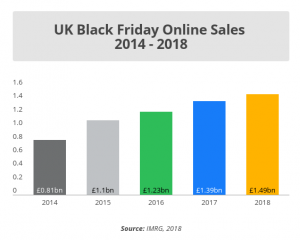
The UK’s online shoppers spent £1.49bn on Black Friday 2018.
Interestingly, the impact and manner in which Black Friday is approached by brands has changed markedly in recent years. This shift has largely been driven by a change in customer behaviour. The vast reams of content being produced around Black Friday has meant shoppers have become accustomed to the lucrative deals that are on offer and tend to hold back spending until this pivotal week arrives. This has led to a number of high-profile retailers to question its value, given it often results in much poorer sales in the weeks directly leading up to Christmas.
However, if a brand does successfully navigate this volatile time of the year, the rewards can be massive.
How to successfully navigate Black Friday and ensure it is part of a longer-term approach?
- Plan early: Be aware that API’s will be overburdened, CPS’s will be through the roof and the traffic could start coming at any time depending on when your competitors have planned in sale activity. Last year alone 45% of shoppers started searching for deals in the week before the main event. It sounds like common sense, but all too many retailers wait until the last minute and a simple issue like site speed could cost them huge revenues. Ultimately it all comes down to preparation.
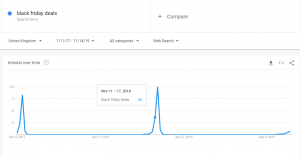
Google Trends: shoppers are becoming accustomed to searching for Black Friday Deals as early as two weeks prior the event, offering early deals can offer a competitive advantage in terms of CPCs.
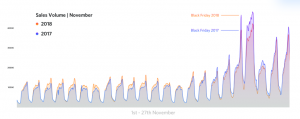
Sale Cycle: Sales Patterns Around Black Friday.
Data on sales volumes last November shows the effect that Black Friday has on ecommerce sales.
Sales are consistent throughout the month, before increasing in the few days before Black Friday.
(The data comes from clients in both the US and UK).
- Integrate messaging: In a world of omnichannel commerce, it has never been more important to ensure consistent messaging across all platforms. It’s important to a have a feedback loop in place where data from ecommerce activity is feeding creative in real-time to ensure media spend is being maximised.
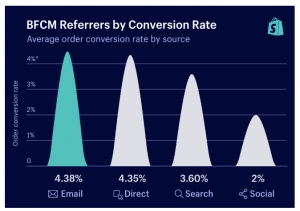
Black Friday conversions by channel.
Stats from Shopify show the best performing channels in terms of conversion rates over Black Friday weekend 2018.
- The long tail: With cost per clicks skyrocketing for key terms particularly around clothing, tech, toys and smart home, make sure to have the best organic exposure possible and build this in the months prior to Black Friday via link building, content syndication, keyword matching and organic reviews.
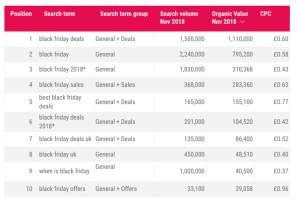
PI Data Metric Report. Individual search terms: sorted by organic value | November 2018. Plan your content around the most valuable generic terms.
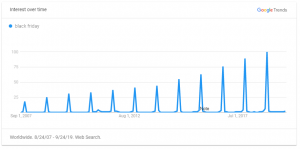
Google Trends: over the last 12 years, search volumes for ‘Black Friday’ have steadily increased.
Typically, search volumes begin to build mid-September, peaking in November. According to Google, Back Friday searches have increased by 80% over the last two years.
- Retargeting strategies: History has shown us that typically customers over the Black Friday period are not the most loyal – they are heavily influenced by price. However, it’s important to retarget your existing customer base with your specific deals, guides and personalised promotions to cut through the ‘noise’.
So, the goal posts maybe changing, but Black Friday continues to be a make or break time for UK retailers, particularly when there are so many uncertain macro-economic factors at play. The key to it being a success is to plan early, personalise, integrate messaging and above all else, have the right products ready for your audience!
By Neilson Hall, Head of Ecommerce UK, OMG Commerce


